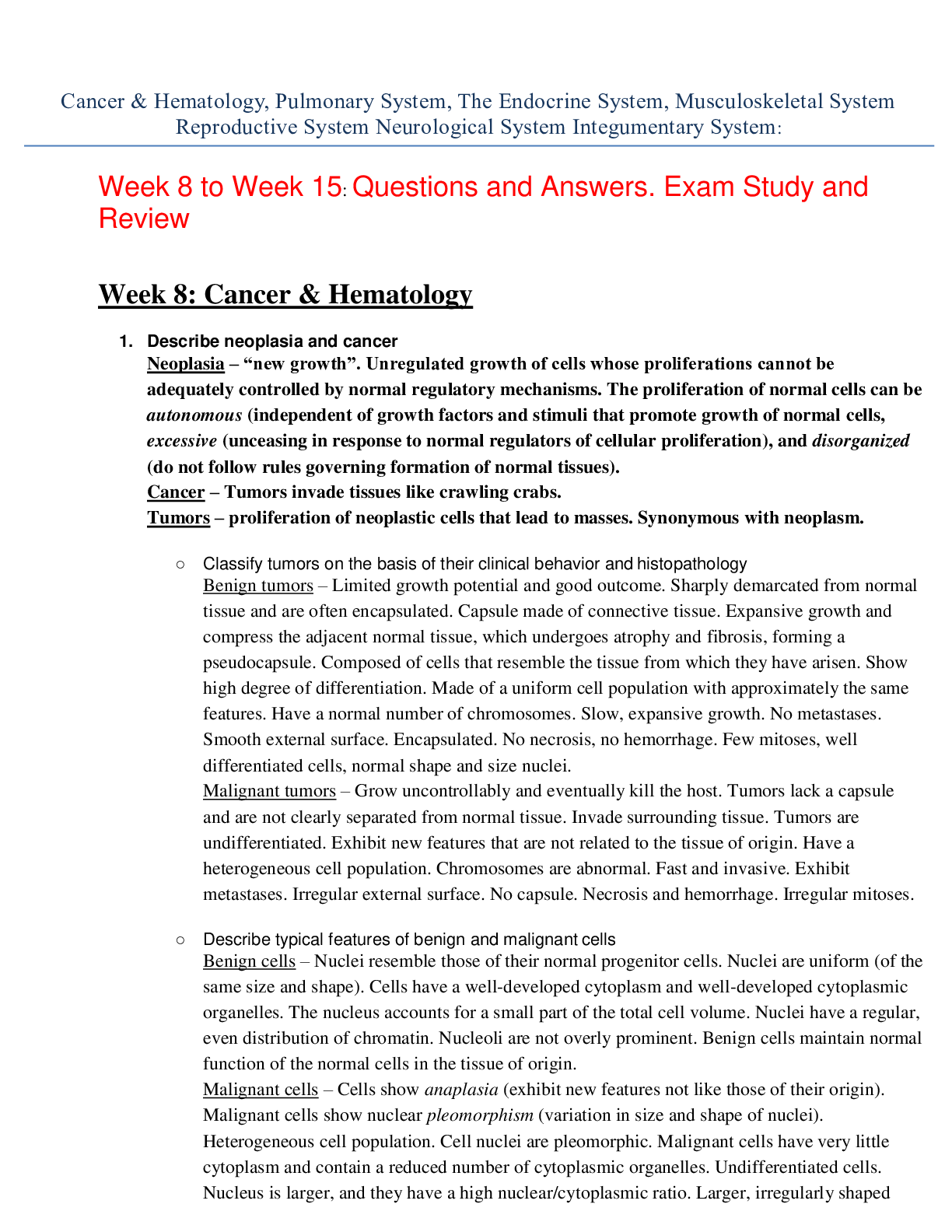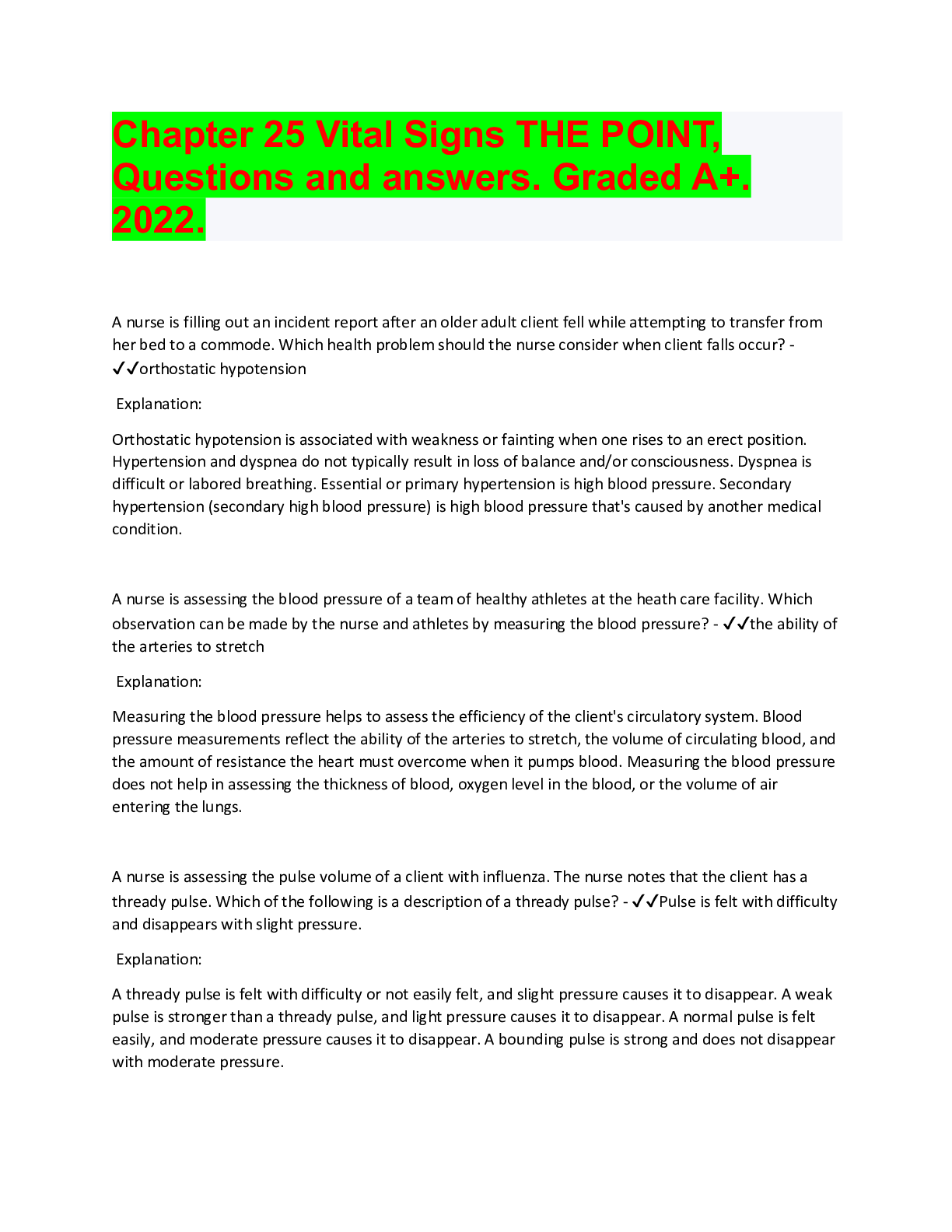
Cancer & Hematology, Pulmonary System, The Endocrine System, Musculoskeletal System Reproductive SystemNeurological SystemIntegumentary System: ::: Questions and Answers. Exam Study and Review
*NURSING > QUESTIONS & ANSWERS > Chapter 25 Vital Signs THE POINT, Questions and answers. Graded A+. 2022. (All)
Chapter 25 Vital Signs THE POINT, Questions and answers. Graded A+. 2022. A nurse is filling out an incident report after an older adult client fell while attempting to transfer from her bed to a ... commode. Which health problem should the nurse consider when client falls occur? - ✔✔orthostatic hypotension Explanation: Orthostatic hypotension is associated with weakness or fainting when one rises to an erect position. Hypertension and dyspnea do not typically result in loss of balance and/or consciousness. Dyspnea is difficult or labored breathing. Essential or primary hypertension is high blood pressure. Secondary hypertension (secondary high blood pressure) is high blood pressure that's caused by another medical condition. A nurse is assessing the blood pressure of a team of healthy athletes at the heath care facility. Which observation can be made by the nurse and athletes by measuring the blood pressure? - ✔✔the ability of the arteries to stretch Explanation: Measuring the blood pressure helps to assess the efficiency of the client's circulatory system. Blood pressure measurements reflect the ability of the arteries to stretch, the volume of circulating blood, and the amount of resistance the heart must overcome when it pumps blood. Measuring the blood pressure does not help in assessing the thickness of blood, oxygen level in the blood, or the volume of air entering the lungs. A nurse is assessing the pulse volume of a client with influenza. The nurse notes that the client has a thready pulse. Which of the following is a description of a thready pulse? - ✔✔Pulse is felt with difficulty and disappears with slight pressure. Explanation: A thready pulse is felt with difficulty or not easily felt, and slight pressure causes it to disappear. A weak pulse is stronger than a thready pulse, and light pressure causes it to disappear. A normal pulse is felt easily, and moderate pressure causes it to disappear. A bounding pulse is strong and does not disappear with moderate pressure.A nurse needs to measure the blood pressure of a client who has just undergone a bilateral mastectomy. How should the nurse measure the blood pressure? - ✔✔Over the client's thigh Explanation: The nurse should measure the blood pressure over the client's thigh or the popliteal artery behind the knee. It is inadvisable following a mastectomy to assess blood pressure at the normal site, which is over the brachial artery at the inner aspect of the elbow. In normal cases, the blood pressure may also be assessed at the lower arm and radial artery. A nurse is assessing an apical pulse on a cardiac client. The client is taking digoxin. The nurse can anticipate that the digoxin will: - ✔✔decrease the apical pulse. Explanation: Certain cardiac medications, such as digoxin, decrease the heart rate. An ultrasonic Doppler is used for: - ✔✔auscultating a pulse that is difficult to palpate. Explanation: A Doppler device can be used to detect a pulse that is not easily palpable. The nurse has completed an assessment and notes that the client's blood pressure is 132/92 mmHg. What is this client's pulse pressure? - ✔✔40 mmHg Explanation: The difference between systolic blood pressure and diastolic blood pressure is called the pulse pressure; 132 − 92 = 40. An older adult client monitors her BP at home. Lately she has been experiencing dizziness and nausea, followed by a headache when she arises from lying down for a nap. She was worried it was her BP so she began measuring the BP after she arose from her nap and found that her BP would drop from 124/82 to 102/70. She called the nurse concerned about her BP. What is the most appropriate information for the nurse to give this client? - ✔✔You may have orthostatic hypotension and should be seen by your health care provider as soon as you can. Explanation: Orthostatic hypotension (postural hypotension) is a decrease in systolic blood pressure of 20 mm Hg or a decrease in diastolic blood pressure of 10 mm Hg within 3 minutes of standing when compared with blood pressure from the sitting or supine position. It results from an inadequate physiologic response to postural (positional) changes in blood pressure. Orthostatic hypotension may be acute or chronic as wellas symptomatic or asymptomatic. It is associated with dizziness, lightheadedness, blurred vision, weakness, fatigue, nausea, palpitations, and headache. Older adults may experience orthostatic hypotension without associated symptoms, leading to falls. [Show More]
Last updated: 3 years ago
Preview 1 out of 22 pages

Buy this document to get the full access instantly
Instant Download Access after purchase
Buy NowInstant download
We Accept:

Can't find what you want? Try our AI powered Search
Connected school, study & course
About the document
Uploaded On
Oct 21, 2022
Number of pages
22
Written in
All
This document has been written for:
Uploaded
Oct 21, 2022
Downloads
0
Views
274
Scholarfriends.com Online Platform by Browsegrades Inc. 651N South Broad St, Middletown DE. United States.
We're available through e-mail, Twitter, Facebook, and live chat.
FAQ
Questions? Leave a message!
Copyright © Scholarfriends · High quality services·